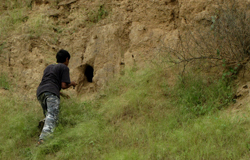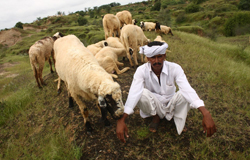Trishant Simlai, BSc Wildlife Conservation, has been working with Tiger Watch in India as a field biologist. Recently Trishant co-ordinated a survey of the Indian Wolf. Read his full report below. The work conducted by Tiger Watch has been reported in Indian national paper The Hindu.
Recently I finished coordinating and conducting a survey to investigate the status and distribution of the Indian wolf in the Sawai Madhopur district in the state of Rajasthan in Western India. I have been working as a field biologist with ‘Tiger watch’, which is a NGO focusing on Conservation action. Wolves in India have lost much of their previous distribution range and inhabit human dominated agro-pastoral landscapes, conservation in such areas is now a severe challenge as there is increasing pressure brought upon by development forces. There has been little scientific study to assess the population of the Indian Wolf and the threats faced by it. Being aware of this problem and hearing regular reports by locals on sightings of wolves, we decided to undertake an expedition to investigate the conservation status of the Indian Wolf and its habitat in the area.
My role as an investigator in the project along with the principal investigator Dr.Dharmendra Khandal was to design the survey, identify the survey sites and analyze the data gathered to suggest conservation measures. I spent the entire first month of the expedition in the field, talking to local pastoralists and interviewing them about their knowledge on the sightings of the Indian Wolf. Once the survey sites were established, I set up transects and identified villages from where socio-economic and background data was to be collected.
The expedition identified patches of ravine land, which were being used by wolves as breeding sites. These ravines are also important pastures for two local communities. Approximately 1000-1200 livestock graze in these ravines everyday. There is also heavy livestock depredation by the wolves and surprisingly tolerance levels among the communities is very high and retaliation low. But, the Indian Government classifies ravines as wastelands due to their detrimental effect on soil fertility and ravine reclamation is a matter of high national priority. The ravines in our study site are facing immediate threats like reclamation, sand mining and conversion to cultivable land.
Our findings were presented to the local authorities last month, and the fact that the ravines were important both to the local communities and the Indian Wolf was stressed upon. We also suggested declaring these ravines as Protected Community Lands (PCL), which could be used as a pasture by the local communities. Local authorities have taken great interest and are now moving forward to halt all reclamation activity in the area. A win-win situation between the Indian Wolf and the local communities seems to have been achieved for now.
In the near future, we want to extend our survey to other potential ravine sites in the vicinity and explore the idea of categorizing ravines into Important ravine areas (IRA) based on the number of threatened species inhabiting them and the dependence of pastoralists on them.





